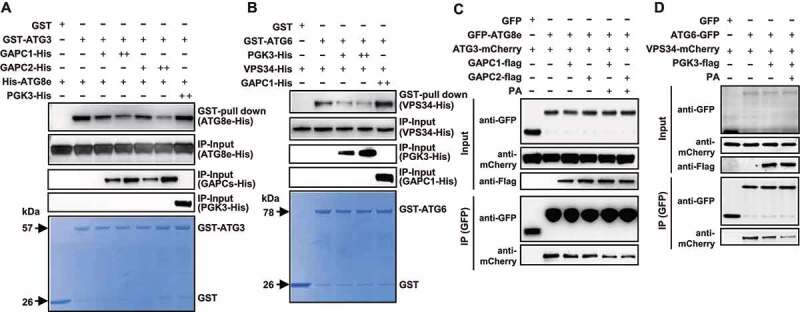Figure 5.

PA attenuates the interaction of ATG3-ATG8e or ATG6-VPS34 by binding to GAPCs or PGK3. (A and B) GST affinity‐isolation assay showed the suppressed ATG3-ATG8e association by GAPCs (A, PGK3-His was used as a negative control) or ATG6-VPS34 association by PGK3 (B, GAPC1-His was used as a negative control). The pellet fraction was eluted and analyzed by immunoblotting using anti-His antibodies (upper panel). Input of GAPCs-His or PGK3-His (middle panel) and equal aliquots of glutathione beads loaded with GST-ATG3 or GST-ATG6 or GST (separated by SDS-PAGE and stained with Coomassie Brilliant Blue, bottom panel) were shown. The experiments were biologically repeated for three times and representative images were shown. (C) GAPCs-Flag and PA inhibit the interaction of ATG3-mCherry and GFP-ATG8e in vivo. GAPCs-Flag or GFP were transiently co-expressed in N. benthamiana leaves with ATG3-mCherry and GFP-ATG8e. After immunoprecipitated by GFP affinity magnetic beads, ATG3-mCherry, GFP-ATG8e, and GAPCs-Flag were detected by immunoblot analyses with anti-mCherry, anti-GFP, and anti-Flag antibody, respectively. (D) PGK3-Flag and PA inhibit the interaction of VPS34-mCherry and ATG6-GFP in vivo. PGK3-Flag or GFP were transiently expressed in N. benthamiana leaves with VPS34-mCherry and ATG6-GFP. After immunoprecipitated by GFP affinity magnetic beads, VPS34-mCherry, ATG6-GFP, and PGK3-Flag were detected by immunoblot analyses with anti-mCherry, anti-GFP, and anti-Flag antibody, respectively.
